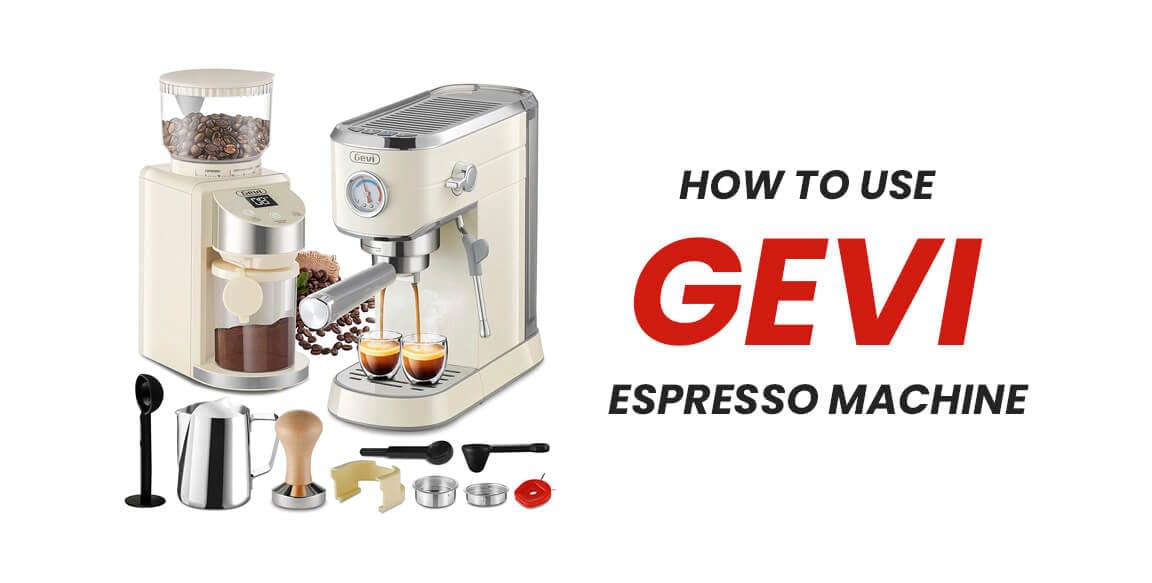If you want to make the most out of your Gevi Espresso Machine, it’s crucial to understand How To Use Gevi Espresso Machine properly. A step-by-step guide will ensure you get the perfect cup of espresso every time. Don’t waste your time and money on trial and error—take action now and follow a detailed outline to master the art of using your Gevi Espresso Machine. It’s time to step up your coffee game and make the ideal espresso at home. Don’t wait any longer; start using your Gevi Espresso Machine like a pro today!
Steps: How To Use Gevi Espresso Machine

1. Unbox and Assemble the Gevi Espresso Machine
Get ready to experience the convenience and luxury of making your espresso at home. Unbox and assemble your Gevi Espresso Machine to start enjoying the rich and robust flavors of freshly brewed espresso. With easy-to-follow instructions, you’ll be sipping on a delicious cup of coffee in no time. Improve your barista talents and impress your friends and family with your superior coffee-making abilities. Don’t wait any longer; start using your Gevi Espresso Machine like a pro today!
2. Familiarize yourself with the machine
The first step to becoming a pro at using your Gevi Espresso Machine is to familiarize yourself with all its features and functions. Learn how to operate the machine correctly, adjust the settings, and understand the different components. This will ensure that you can make the perfect cup of espresso every time. Don’t be intimidated by the machine; embrace it and take the time to get to know it inside and out. With some practice, you’ll be brewing delicious espresso like a true barista in no time. So, don’t hesitate, to start familiarizing yourself with your Espresso machine today and elevate your coffee experience to a whole new level.
3. Prepare the ingredients
Make sure you have the water, coffee grinds, and other components needed to prepare espresso. Everything should be ready and waiting to make things move a lot more smoothly.
4. Fill the water tank
Fill the Gevi Espresso Machine’s water tank with cold, fresh water. This will guarantee that the flavor and quality of your espresso are at their peak.
5. Add the coffee grounds
To ensure consistent and gentle tamping, add the recommended quantity of coffee grinds to the portafilter.
6. Select Your Desired Brewing Option
Once the coffee grounds are in place, it’s time to select your desired brewing option. Whether it’s a single shot, double shot, or any other custom setting, make sure to choose the right option for your preferred strength and flavor of espresso. This step will ensure that you get the perfect cup of espresso every time. So, take your time to select the right brewing option and enjoy your delicious espresso!
7. Froth Milk (if desired)
Now that your espresso is brewing, it’s time to prepare the milk. If you enjoy a creamy and frothy texture in your espresso, then frothing the milk is a crucial step. You can accomplish this by utilizing your espresso machine’s steam wand or milk frother. Just fill the frother with the appropriate amount of milk. and turn it on to create that perfect froth for your espresso. This step gives your drink a touch of luxury and enhances the overall experience. So, take this step to elevate your espresso to the next level!
8. Start the brewing process
Once everything is in place, start the brewing process by pressing the appropriate buttons on the machine. Follow the specific guidance for your model to ensure the best results.
9. Enjoy your espresso
After the brewing process is finished, Enjoy your freshly made espresso after pouring it into a cup! Don’t forget to clean the machine and put everything back in its place for the next use. Happy brewing!
Cleaning and Maintenance Tips

1. Regular cleaning
To make sure your espresso machine keeps making great coffee, it’s critical to clean it regularly. The flavor and quality of your espresso may be impacted by an accumulation of coffee oils and residue.
2. Use the right cleaning products
Make sure you use the appropriate cleaning products for your espresso machine. The machine may get damaged if the wrong products are used and affect the taste of your coffee.
3. Clean the steam wand
The steam wand is an essential part of an espresso machine, and it’s important to keep it clean to avoid any blockages or buildup of milk residue.
4. Descale the machine
Over time, Your espresso maker may accumulate mineral deposits, affecting its performance. Regular descaling will help to keep your machine in top condition.
5. Check the water quality
The taste of your coffee can be significantly influenced by the quality of the water you use in your espresso machine. To avoid any undesirable flavors, use filtered water.
6. Replace worn parts
Pay attention to your machine’s condition. To make sure it keeps working correctly, replace any worn-out or damaged parts.
7. Regular maintenance
Besides regular cleaning, it’s important to schedule regular maintenance for your espresso machine to keep it in top condition.
8. Store it properly
When not in use, make sure to store your espresso machine in a clean and dry environment to avoid any damage or buildup of dust and debris.
9. Seek professional help
If there are any problems with your espresso maker that you can’t resolve on your own, don’t hesitate to seek professional help to avoid any further damage.
Cleaning and maintaining your espresso machine is crucial for ensuring it continues producing delicious coffee. Make sure to regularly descale the machine, clean the portafilter and group head, and wipe down the machine’s exterior. By taking care of your espresso machine, you can make sure that it continues to produce high-quality coffee for years to come. Also, check our post about tea vs coffee for Anxiety.
Conclusion
Using a Gevi espresso machine is a great way to make delicious, high-quality coffee at home. By following the simple steps outlined in this post, you can easily create barista-worthy espresso drinks in the comfort of your kitchen. Don’t be intimidated by the machine – with a little practice, you’ll be a pro in no time. So go ahead, give it a try, and start savoring your preferred coffee beverages in the comfort of your own house. Cheers to great coffee!





